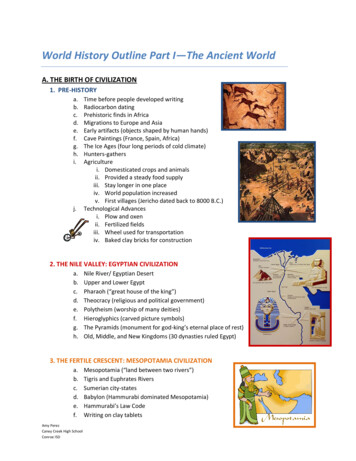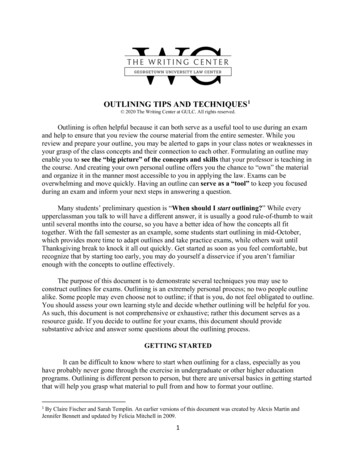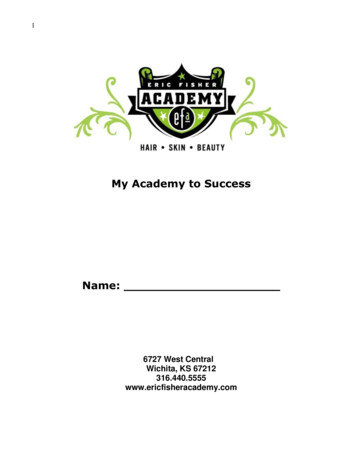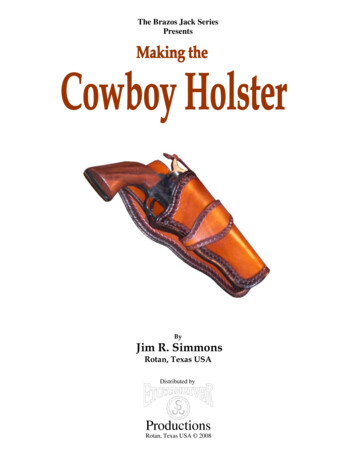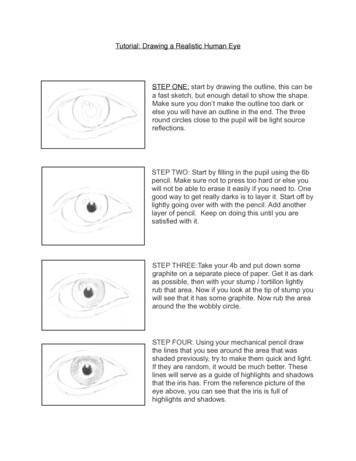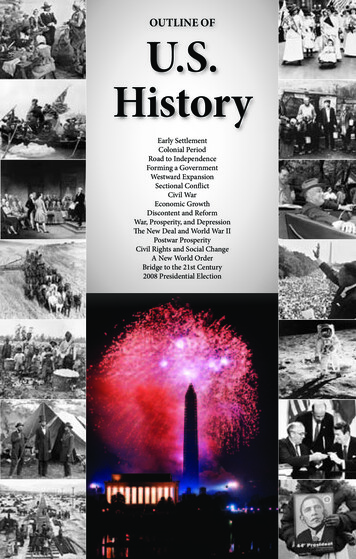
Transcription
OUTLINE OFU.S.HistoryEarly SettlementColonial PeriodRoad to IndependenceForming a GovernmentWestward ExpansionSectional ConflictCivil WarEconomic GrowthDiscontent and ReformWar, Prosperity, and DepressionThe New Deal and World War IIPostwar ProsperityCivil Rights and Social ChangeA New World OrderBridge to the 21st Century2008 Presidential Election
U.S. HISTORYOUUTTLL II NNEE OOFFOBureau of International Information ProgramsU.S. Department of State2011
U.S. HISTORYOUUTTLLIINNEE OOFFOCONTENTSCHAPTER 1 Early America . . . . . . . . . . . . . . . . . . . . . . . . . . . . . . . . . . . . . . . 4CHAPTER 2 The Colonial Period . . . . . . . . . . . . . . . . . . . . . . . . . . . . . . . . 22CHAPTER 3 The Road to Independence . . . . . . . . . . . . . . . . . . . . . . . . . . 50CHAPTER 4 The Formation of a National Government . . . . . . . . . . . . 66CHAPTER 5 Westward Expansion and Regional Differences . . . . . . . 110CHAPTER 6 Sectional Conflict . . . . . . . . . . . . . . . . . . . . . . . . . . . . . . . . . 128CHAPTER 7 The Civil War and Reconstruction . . . . . . . . . . . . . . . . . . 140CHAPTER 8 Growth and Transformation . . . . . . . . . . . . . . . . . . . . . . . . 154CHAPTER 9 Discontent and Reform . . . . . . . . . . . . . . . . . . . . . . . . . . . . 188CHAPTER 10 War, Prosperity, and Depression . . . . . . . . . . . . . . . . . . . . 202CHAPTER 11 The New Deal and World War II . . . . . . . . . . . . . . . . . . . . 212CHAPTER 12 Postwar America . . . . . . . . . . . . . . . . . . . . . . . . . . . . . . . . . . 256CHAPTER 13 Decades of Change: 1960-1980 . . . . . . . . . . . . . . . . . . . . . . 274CHAPTER 14 The New Conservatism and a New World Order . . . . . . 304CHAPTER 15 Bridge to the 21st Century . . . . . . . . . . . . . . . . . . . . . . . . . 320CHAPTER 16 Politics of Hope . . . . . . . . . . . . . . . . . . . . . . . . . . . . . . . . . . . 340PICTURE PROFILESBecoming a Nation . . . . . . . . . . . . . . . . . . . . . . . . . . . . . . . . . 38Transforming a Nation . . . . . . . . . . . . . . . . . . . . . . . . . . . . . . 89Monuments and Memorials . . . . . . . . . . . . . . . . . . . . . . . . 161Turmoil and Change . . . . . . . . . . . . . . . . . . . . . . . . . . . . . . . 22921st Century Nation . . . . . . . . . . . . . . . . . . . . . . . . . . . . . . . 293Bibliography . . . . . . . . . . . . . . . . . . . . . . . . . . . . . . . . . . . . . . . . . . . . . . . . . . . 346Index . . . . . . . . . . . . . . . . . . . . . . . . . . . . . . . . . . . . . . . . . . . . . . . . . . . . . . . . . 349
4
1CHAPTEREARLYAMERICAMesa Verde settlement inColorado, 13th century.
CHAPTER 1: EARLY AMERICA“Heaven and Earth neveragreed better to frame a placefor man’s habitation.”Jamestown founder John Smith, 1607ancestors had for thousands of years,along the Siberian coast and thenacross the land bridge.Once in Alaska, it would takethese first North Americans thousands of years more to work theirway through the openings in greatglaciers south to what is now theUnited States. Evidence of early lifein North America continues to befound. Little of it, however, can bereliably dated before 12,000 B.C.; arecent discovery of a hunting lookout in northern Alaska, for example, may date from almost that time.So too may the finely crafted spearpoints and items found near Clovis,New Mexico.Similar artifacts have been foundat sites throughout North and SouthAmerica, indicating that life wasprobably already well established inTHE FIRST AMERICANSAt the height of the Ice Age, between 34,000 and 30,000 B.C., muchof the world’s water was locked upin vast continental ice sheets. As aresult, the Bering Sea was hundredsof meters below its current level, anda land bridge, known as Beringia,emerged between Asia and NorthAmerica. At its peak, Beringia isthought to have been some 1,500 kilometers wide. A moist and treelesstundra, it was covered with grassesand plant life, attracting the largeanimals that early humans huntedfor their survival.The first people to reach NorthAmerica almost certainly did sowithout knowing they had crossedinto a new continent. They wouldhave been following game, as their6
OUTLINE OF U.S. HISTORYmuch of the Western Hemisphere bysome time prior to 10,000 B.C.Around that time the mammothbegan to die out and the bison tookits place as a principal source offood and hides for these early NorthAmericans. Over time, as more andmore species of large game vanished — whether from overhuntingor natural causes — plants, berries,and seeds became an increasinglyimportant part of the early American diet. Gradually, foraging andthe first attempts at primitive agriculture appeared. Native Americansin what is now central Mexico ledthe way, cultivating corn, squash,and beans, perhaps as early as 8,000B.C. Slowly, this knowledge spreadnorthward.By 3,000 B.C., a primitive type ofcorn was being grown in the rivervalleys of New Mexico and Arizona. Then the first signs of irrigationbegan to appear, and, by 300 B.C.,signs of early village life.By the first centuries A.D., theHohokam were living in settlementsnear what is now Phoenix, Arizona, where they built ball courts andpyramid-like mounds reminiscentof those found in Mexico, as well asa canal and irrigation system.ing earthen burial sites and fortifications around 600 B.C. Somemounds from that era are in theshape of birds or serpents; theyprobably served religious purposesnot yet fully understood.The Adenans appear to havebeen absorbed or displaced by various groups collectively known asHopewellians. One of the most important centers of their culture wasfound in southern Ohio, where theremains of several thousand of thesemounds still can be seen. Believedto be great traders, the Hopewellians used and exchanged tools andmaterials across a wide region ofhundreds of kilometers.By around 500 A.D., theHopewellians disappeared, too,gradually giving way to a broadgroup of tribes generally knownas the Mississippians or TempleMound culture. One city, Cahokia, near Collinsville, Illinois, isthought to have had a population ofabout 20,000 at its peak in the early12th century. At the center of thecity stood a huge earthen mound,flattened at the top, that was 30meters high and 37 hectares at thebase. Eighty other mounds havebeen found nearby.Cities such as Cahokia depended on a combination of hunting,foraging, trading, and agriculturefor their food and supplies. Influenced by the thriving societies to thesouth, they evolved into complex hierarchical societies that took slavesand practiced human sacrifice.MOUND BUILDERS ANDPUEBLOSThe first Native-American groupto build mounds in what is now theUnited States often are called theAdenans. They began construct-7
CHAPTER 1: EARLY AMERICAIn what is now the southwestUnited States, the Anasazi, ancestorsof the modern Hopi Indians, beganbuilding stone and adobe pueblosaround the year 900. These uniqueand amazing apartment-like structures were often built along clifffaces; the most famous, the “cliffpalace” of Mesa Verde, Colorado,had more than 200 rooms. Anothersite, the Pueblo Bonito ruins alongNew Mexico’s Chaco River, oncecontained more than 800 rooms.Perhaps the most affluent of thepre-Columbian Native Americanslived in the Pacific Northwest, wherethe natural abundance of fish andraw materials made food suppliesplentiful and permanent villages possible as early as 1,000 B.C. The opulence of their “potlatch” gatheringsremains a standard for extravaganceand festivity probably unmatched inearly American history.the indigenous population practically from the time of initial contact. Smallpox, in particular, ravagedwhole communities and is thoughtto have been a much more directcause of the precipitous decline inthe Indian population in the 1600sthan the numerous wars and skirmishes with European settlers.Indian customs and culture at thetime were extraordinarily diverse,as could be expected, given the expanse of the land and the many different environments to which theyhad adapted. Some generalizations,however, are possible. Most tribes,particularly in the wooded easternregion and the Midwest, combinedaspects of hunting, gathering, andthe cultivation of maize and otherproducts for their food supplies.In many cases, the women wereresponsible for farming and thedistribution of food, while the menhunted and participated in war.NATIVE-AMERICANBy all accounts, Native-AmericanCULTURESsociety in North America was closelytied to the land. Identification withhe America that greeted the first nature and the elements was integralEuropeans was, thus, far from an to religious beliefs. Their life wasempty wilderness. It is now thought essentially clan-oriented and comthat as many people lived in the munal, with children allowed moreWestern Hemisphere as in West- freedom and tolerance than was theern Europe at that time — about 40 European custom of the day.million. Estimates of the number ofAlthough some North AmeriNative Americans living in what is can tribes developed a type of hinow the United States at the onset of eroglyphics to preserve certainEuropean colonization range from texts, Native-American culture wastwo to 18 million, with most histori- primarily oral, with a high valueans tending toward the lower figure. placed on the recounting of talesWhat is certain is the devastating ef- and dreams. Clearly, there was afect that European disease had on good deal of trade among variousT8
OUTLINE OF U.S. HISTORYgroups and strong evidence existsColumbus never saw the mainthat neighboring tribes maintained land of the future United States,extensive and formal relations — but the first explorations of it wereboth friendly and hostile.launched from the Spanish possessions that he helped establish. TheTHE FIRST EUROPEANSfirst of these took place in 1513when a group of men under Juanhe first Europeans to arrive in Ponce de León landed on the FloridaNorth America — at least the first coast near the present city of St.for whom there is solid evidence Augustine.— were Norse, traveling west fromWith the conquest of Mexico inGreenland, where Erik the Red 1522, the Spanish further solidihad founded a settlement around fied their position in the Westernthe year 985. In 1001 his son Leif is Hemisphere. The ensuing discovthought to have explored the north- eries added to Europe’s knowledgeeast coast of what is now Canada and of what was now named Americaspent at least one winter there.— after the Italian Amerigo VesWhile Norse sagas suggest that pucci, who wrote a widely popularViking sailors explored the Atlan- account of his voyages to a “Newtic coast of North America down World.” By 1529 reliable maps of theas far as the Bahamas, such claims Atlantic coastline from Labradorremain unproven. In 1963, however, to Tierra del Fuego had been drawnthe ruins of some Norse houses dat- up, although it would take more thaning from that era were discovered at another century before hope of disL’Anse-aux-Meadows in northern covering a “Northwest Passage” toNewfoundland, thus supporting at Asia would be completely abandoned.least some of the saga claims.Among the most significant earIn 1497, just five years after ly Spanish explorations was that ofChristopher Columbus landed in Hernando De Soto, a veteran conthe Caribbean looking for a west- quistador who had accompaniedern route to Asia, a Venetian sail- Francisco Pizarro in the conquest ofor named John Cabot arrived in Peru. Leaving Havana in 1539, DeNewfoundland on a mission for Soto’s expedition landed in Floridathe British king. Although quickly and ranged through the southeastforgotten, Cabot’s journey was later ern United States as far as the Missisto provide the basis for British claims sippi River in search of riches.to North America. It also openedAnother Spaniard, Francisthe way to the rich fishing grounds co Vázquez de Coronado, set outoff George’s Banks, to which Eu- from Mexico in 1540 in search ofropean fishermen, particularly the the mythical Seven Cities of CiboPortuguese, were soon making reg- la. Coronado’s travels took him toular visits.the Grand Canyon and Kansas, butT9
CHAPTER 1: EARLY AMERICAfailed to reveal the gold or treasurehis men sought. However, his party did leave the peoples of the region a remarkable, if unintended,gift: Enough of his horses escapedto transform life on the Great Plains.Within a few generations, the PlainsIndians had become masters ofhorsemanship, greatly expandingthe range of their activities.While the Spanish were pushingup from the south, the northern portion of the present-day United Stateswas slowly being revealed throughthe journeys of men such as Giovanni da Verrazano. A Florentine whosailed for the French, Verrazanomade landfall in North Carolina in1524, then sailed north along the Atlantic Coast past what is now NewYork harbor.A decade later, the FrenchmanJacques Cartier set sail with the hope— like the other Europeans beforehim — of finding a sea passage toAsia. Cartier’s expeditions along theSt. Lawrence River laid the foundation for the French claims to NorthAmerica, which were to last until1763.Following the collapse of theirfirst Quebec colony in the 1540s,French Huguenots attempted to settle the northern coast of Florida twodecades later. The Spanish, viewingthe French as a threat to their traderoute along the Gulf Stream, destroyed the colony in 1565. Ironically, the leader of the Spanish forces,Pedro Menéndez, would soon establish a town not far away — St. Augustine. It was the first permanentEuropean settlement in what wouldbecome the United States.The great wealth that poured intoSpain from the colonies in Mexico,the Caribbean, and Peru provokedgreat interest on the part of the otherEuropean powers. Emerging maritime nations such as England, drawnin part by Francis Drake’s successful raids on Spanish treasure ships,began to take an interest in the NewWorld.In 1578 Humphrey Gilbert, theauthor of a treatise on the searchfor the Northwest Passage, receiveda patent from Queen Elizabeth tocolonize the “heathen and barbarous landes” in the New World thatother European nations had not yetclaimed. It would be five years beforehis efforts could begin. When he waslost at sea, his half-brother, WalterRaleigh, took up the mission.In 1585 Raleigh established thefirst British colony in North America, on Roanoke Island off the coastof North Carolina. It was later abandoned, and a second effort two yearslater also proved a failure. It wouldbe 20 years before the British wouldtry again. This time — at Jamestownin 1607 — the colony would succeed,and North America would enter anew era.EARLY SETTLEMENTSThe early 1600s saw the beginning of a great tide of emigrationfrom Europe to North America.Spanning more than three centuries,this movement grew from a trickle10
OUTLINE OF U.S. HISTORYof a few hundred English coloniststo a flood of millions of newcomers.Impelled by powerful and diversemotivations, they built a new civilization on the northern part of thecontinent.The first English immigrantsto what is now the United Statescrossed the Atlantic long after thriving Spanish colonies had been established in Mexico, the West Indies,and South America. Like all earlytravelers to the New World, theycame in small, overcrowded ships.During their six- to 12-week voyages, they lived on meager rations.Many died of disease, ships wereoften battered by storms, and somewere lost at sea.Most European emigrants lefttheir homelands to escape politicaloppression, to seek the freedom topractice their religion, or to find opportunities denied them at home.Between 1620 and 1635, economicdifficulties swept England. Manypeople could not find work. Evenskilled artisans could earn littlemore than a bare living. Poor cropyields added to the distress. In addition, the Commercial Revolutionhad created a burgeoning textileindustry, which demanded an everincreasing supply of wool to keepthe looms running. Landlords enclosed farmlands and evicted thepeasants in favor of sheep cultivation. Colonial expansion becamean outlet for this displaced peasantpopulation.The colonists’ first glimpse ofthe new land was a vista of densewoods. The settlers might not havesurvived had it not been for thehelp of friendly Indians, who taughtthem how to grow native plants —pumpkin, squash, beans, and corn.In addition, the vast, virgin forests,extending nearly 2,100 kilometersalong the Eastern seaboard, proveda rich source of game and firewood.They also provided abundant rawmaterials used to build houses, furniture, ships, and profitable itemsfor export.Although the new continent wasremarkably endowed by nature,trade with Europe was vital for articles the settlers could not produce.The coast served the immigrantswell. The whole length of shore provided many inlets and harbors. Onlytwo areas — North Carolina andsouthern New Jersey — lacked harbors for ocean-going vessels.Majestic rivers — the Kennebec,Hudson, Delaware, Susquehanna,Potomac, and numerous others —linked lands between the coast andthe Appalachian Mountains withthe sea. Only one river, however, theSt. Lawrence — dominated by theFrench in Canada — offered a waterpassage to the Great Lakes and theheart of the continent. Dense forests,the resistance of some Indian tribes,and the formidable barrier of theAppalachian Mountains discouraged settlement beyond the coastalplain. Only trappers and tradersventured into the wilderness. Forthe first hundred years the colonistsbuilt their settlements compactlyalong the coast.11
CHAPTER 1: EARLY AMERICAPolitical considerations influenced many people to move toAmerica. In the 1630s, arbitrary ruleby England’s Charles I gave impetusto the migration. The subsequent revolt and triumph of Charles’ opponents under Oliver Cromwell in the1640s led many cavaliers — “king’smen” — to cast their lot in Virginia.In the German-speaking regions ofEurope, the oppressive policies ofvarious petty princes — particularlywith regard to religion — and thedevastation caused by a long seriesof wars helped swell the movementto America in the late 17th and 18thcenturies.The journey entailed carefulplanning and management, as wellas considerable expense and risk.Settlers had to be transported nearly5,000 kilometers across the sea. Theyneeded utensils, clothing, seed, tools,building materials, livestock, arms,and ammunition. In contrast to thecolonization policies of other countries and other periods, the emigration from England was not directlysponsored by the government but byprivate groups of individuals whosechief motive was profit.they chose a site about 60 kilometersup the James River from the bay.Made up of townsmen and adventurers more interested in findinggold than farming, the group wasunequipped by temperament or ability to embark upon a completely newlife in the wilderness. Among them,Captain John Smith emerged as thedominant figure. Despite quarrels,starvation, and Native-Americanattacks, his ability to enforce discipline held the little colony togetherthrough its first year.In 1609 Smith returned to England, and in his absence, the colonydescended into anarchy. During thewinter of 1609-1610, the majority ofthe colonists succumbed to disease.Only 60 of the original 300 settlerswere still alive by May 1610. Thatsame year, the town of Henrico (nowRichmond) was established fartherup the James River.It was not long, however, beforea development occurred that revolutionized Virginia’s economy. In1612 John Rolfe began cross-breeding imported tobacco seed from theWest Indies with native plants andproduced a new variety that waspleasing to European taste. The firstJAMESTOWNshipment of this tobacco reachedLondon in 1614. Within a decade ithe first of the British colonies had become Virginia’s chief sourceto take hold in North America was of revenue.Jamestown. On the basis of a charProsperity did not come quickly,ter which King James I granted to however, and the death rate fromthe Virginia (or London) Company, disease and Indian attacks remaineda group of about 100 men set out for extraordinarily high. Between 1607the Chesapeake Bay in 1607. Seeking and 1624 approximately 14,000 peoto avoid conflict with the Spanish, ple migrated to the colony, yet onlyT12
OUTLINE OF U.S. HISTORY1,132 were living there in 1624. Onrecommendation of a royal commission, the king dissolved the VirginiaCompany, and made it a royal colonythat year.nized government, the men drafteda formal agreement to abide by “justand equal laws” drafted by leadersof their own choosing. This was theMayflower Compact.In December the Mayflowerreached Plymouth harbor; the Pilgrims began to build their settlement during the winter. Nearly halfthe colonists died of exposure anddisease, but neighboring Wampanoag Indians provided the information that would sustain them: howto grow maize. By the next fall, thePilgrims had a plentiful crop of corn,and a growing trade based on fursand lumber.A new wave of immigrants arrived on the shores of MassachusettsBay in 1630 bearing a grant fromKing Charles I to establish a colony.Many of them were Puritans whosereligious practices were increasinglyprohibited in England. Their leader,John Winthrop, urged them to create a “city upon a hill” in the NewWorld — a place where they wouldlive in strict accordance with theirreligious beliefs and set an examplefor all of Christendom.The Massachusetts Bay Colonywas to play a significant role in thedevelopment of the entire New England region, in part because Winthrop and his Puritan colleagueswere able to bring their charter withthem. Thus the authority for the colony’s government resided in Massachusetts, not in England.Under the charter’s provisions,power rested with the GeneralCourt, which was made up of “free-MASSACHUSETTSDuring the religious upheavalsof the 16th century, a body of menand women called Puritans soughtto reform the Established Church ofEngland from within. Essentially,they demanded that the rituals andstructures associated with RomanCatholicism be replaced by simplerCalvinist Protestant forms of faithand worship. Their reformist ideas,by destroying the unity of the statechurch, threatened to divide thepeople and to undermine royalauthority.In 1607 a small group of Separatists — a radical sect of Puritanswho did not believe the EstablishedChurch could ever be reformed —departed for Leyden, Holland, wherethe Dutch granted them asylum.However, the Calvinist Dutch restricted them mainly to low-paid laboring jobs. Some members of thecongregation grew dissatisfied withthis discrimination and resolved toemigrate to the New World.In 1620, a group of Leyden Puritans secured a land patent from theVirginia Company. Numbering 101,they set out for Virginia on the Mayflower. A storm sent them far northand they landed in New Englandon Cape Cod. Believing themselvesoutside the jurisdiction of any orga13
CHAPTER 1: EARLY AMERICAmen” required to be members of thePuritan, or Congregational, Church.This guaranteed that the Puritanswould be the dominant political aswell as religious force in the colony.The General Court elected the governor, who for most of the next generation would be John Winthrop.The rigid orthodoxy of the Puritan rule was not to everyone’s liking. One of the first to challenge theGeneral Court openly was a youngclergyman named Roger Williams,who objected to the colony’s seizureof Indian lands and advocated separation of church and state. Anotherdissenter, Anne Hutchinson, challenged key doctrines of Puritan theology. Both they and their followerswere banished.Williams purchased land fromthe Narragansett Indians in what isnow Providence, Rhode Island, in1636. In 1644, a sympathetic Puritan-controlled English Parliamentgave him the charter that establishedRhode Island as a distinct colonywhere complete separation of churchand state as well as freedom of religion was practiced.So-called heretics like Williamswere not the only ones who left Massachusetts. Orthodox Puritans, seeking better lands and opportunities,soon began leaving MassachusettsBay Colony. News of the fertility ofthe Connecticut River Valley, for instance, attracted the interest of farmers having a difficult time with poorland. By the early 1630s, many wereready to brave the danger of Indianattack to obtain level ground anddeep, rich soil. These new communities often eliminated church membership as a prerequisite for voting,thereby extending the franchise toever larger numbers of men.At the same time, other settlements began cropping up along theNew Hampshire and Maine coasts,as more and more immigrantssought the land and liberty the NewWorld seemed to offer.NEW NETHERLAND ANDMARYLANDHired by the Dutch East IndiaCompany, Henry Hudson in 1609explored the area around what isnow New York City and the riverthat bears his name, to a point probably north of present-day Albany,New York. Subsequent Dutch voyages laid the basis for their claimsand early settlements in the area.As with the French to the north,the first interest of the Dutch was thefur trade. To this end, they cultivatedclose relations with the Five Nationsof the Iroquois, who were the key tothe heartland from which the furscame. In 1617 Dutch settlers built afort at the junction of the Hudsonand the Mohawk Rivers, where Albany now stands.Settlement on the island of Manhattan began in the early 1620s. In1624, the island was purchased fromlocal Native Americans for the reported price of 24. It was promptlyrenamed New Amsterdam.In order to attract settlers to theHudson River region, the Dutch en14
OUTLINE OF U.S. HISTORYcouraged a type of feudal aristocracy, known as the “patroon” system.The first of these huge estates wereestablished in 1630 along the Hudson River. Under the patroon system, any stockholder, or patroon,who could bring 50 adults to his estate over a four-year period was given a 25-kilometer river-front plot,exclusive fishing and hunting privileges, and civil and criminal jurisdiction over his lands. In turn, heprovided livestock, tools, and buildings. The tenants paid the patroonrent and gave him first option onsurplus crops.Further to the south, a Swedishtrading company with ties to theDutch attempted to set up its firstsettlement along the Delaware River three years later. Without the resources to consolidate its position,New Sweden was gradually absorbedinto New Netherland, and later,Pennsylvania and Delaware.In 1632 the Catholic Calvert family obtained a charter for land northof the Potomac River from KingCharles I in what became known asMaryland. As the charter did not expressly prohibit the establishment ofnon-Protestant churches, the colonybecame a haven for Catholics. Maryland’s first town, St. Mary’s, wasestablished in 1634 near where thePotomac River flows into the Chesapeake Bay.While establishing a refuge forCatholics, who faced increasing persecution in Anglican England, theCalverts were also interested in creating profitable estates. To this end,and to avoid trouble with the Britishgovernment, they also encouragedProtestant immigration.Maryland’s royal charter hada mixture of feudal and modernelements. On the one hand theCalvert family had the power tocreate manorial estates. On the other, they could only make laws withthe consent of freemen (propertyholders). They found that in orderto attract settlers — and make aprofit from their holdings — theyhad to offer people farms, not justtenancy on manorial estates. Thenumber of independent farms grewin consequence. Their owners demanded a voice in the affairs of thecolony. Maryland’s first legislaturemet in 1635.COLONIAL-INDIANRELATIONSBy 1640 the British had solidcolonies established along the NewEngland coast and the ChesapeakeBay. In between were the Dutch andthe tiny Swedish community. To thewest were the original Americans,then called Indians.Sometimes friendly, sometimeshostile, the Eastern tribes were nolonger strangers to the Europeans.Although Native Americans benefited from access to new technology and trade, the disease and thirstfor land that the early settlers alsobrought posed a serious challenge totheir long-established way of life.At first, trade with the Europeansettlers brought advantages: knives,15
CHAPTER 1: EARLY AMERICAaxes, weapons, cooking utensils,fishhooks, and a host of other goods.Those Indians who traded initially had significant advantage overrivals who did not. In response toEuropean demand, tribes such as theIroquois began to devote more attention to fur trapping during the17th century. Furs and pelts provided tribes the means to purchasecolonial goods until late into the18th century.Early colonial-Native-Americanrelations were an uneasy mix of cooperation and conflict. On the onehand, there were the exemplary relations that prevailed during the firsthalf century of Pennsylvania’s existence. On the other were a long seriesof setbacks, skirmishes, and wars,which almost invariably resulted inan Indian defeat and further loss ofland.The first of the important NativeAmerican uprisings occurred in Virginia in 1622, when some 347 whiteswere killed, including a number ofmissionaries who had just recentlycome to Jamestown.White settlement of the Connecticut River region touched off thePequot War in 1637. In 1675 KingPhilip, the son of the native chiefwho had made the original peacewith the Pilgrims in 1621, attempte
4678910243265B52E9B74CO 7 much of the Western Hemisphere by some time prior to 10,000 B .C . Around that time


